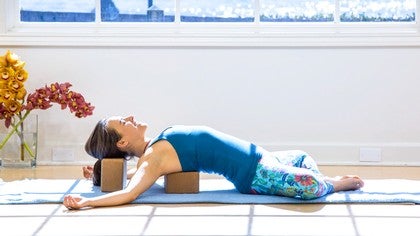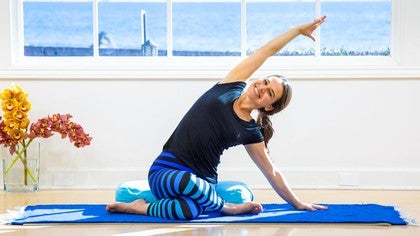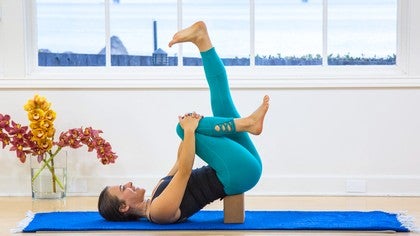Description
About This Video
Transcript
Read Full Transcript
We'll begin to find a yin-like stretch for the chest, the shoulders, and the front of the body coming into impressing the heart butterfly. So you'll want two blocks for this opening. And as usual, start with the block at the highest setting under your head, supporting your skull, and then the second block directly beneath the shoulder blades. And this is one of my very favorite postures. It's so effective and helps to create this feeling of opening and broadening and expansion through the front of the body to counter pose kind of this rolling, slumpy, rounded shape we find ourselves in most of the time.
So set yourself up and then come on down. And where the blocks are matters. So you want to make sure it feels just right for you. And position the block directly beneath your shoulder blades. So it's less of a back bend and more of a chest opener supporting the upper body.
And then we'll bring the soles of the feet together, knees wide. So coming into a butterfly shape. And then allowing the back of the neck to lengthen, feeling the shoulders and the shoulder blades kind of roll and slide down the back. Beautiful. And you might let the hands turn up towards the sky.
You might keep the arms where they are. You might choose to stretch the arms out a bit wider, coming into like a cactus butterfly shape. Is to feel that stretch and opening through the shoulders and the front of the body. And there's a slight softening or drawing of the chin downward towards the chest to allow the base of the skull to feel a bit more wide and open. Letting the eyes soften, letting the jaw hinge release.
And for the next minute or so here, begin to draw your attention inward towards your breath. Just become aware of the quality of your breath in this shape with the block in your back. Become aware of any sensation through the upper chest, around your collarbones, sternum, rib cage, belly. And then bring some attention towards the quality, the feeling of each exhalation. And allowing each exhale to help encourage this process of softening and releasing towards the support.
So allowing the weight of the skull, the head to get heavy. And allowing the upper back and the shoulder blades to continue to soften. Now as you settle in, you might keep your head right where it is at that highest setting in the block. You might choose to now lower it down to that second or maybe even the first side. And placing it towards the back part of the skull, keeping it spacious around the neck and the arms might stretch out to your sides.
And allow for an exhale, letting the lower ribs soften. Providing gravity to assist in this stretch and opening through the pelvis and the hips. So allowing the knees to get heavy. Become aware of your relationship with the back of the body and the support. You might even feel the movement of the breath around the back of the heart.
You might choose to keep your arms where they are. You might choose to stretch your arms overhead a bit and allowing the elbows to bend. If this creates too much stress or strain on your shoulders, then you can just simply release the arms where they're comfortable. And allowing each exhalation to invite the body to release towards the support. And to assist, you might even visualize or imagine your body like a body of water or a river washing over the support of the blocks.
Feeling the support beneath you as you feel ready, use your hands outside of your knees to draw your knees towards each other and just allow your legs to stretch out for a moment and it might feel nice to point and flex your feet, circling the ankles, circling the wrists in one direction and the other. And you might invite some movement through the neck, allowing the head to roll in one direction and back up to center and in the other direction, kind of unwinding the neck. And then from here, bending the knees, rolling to a side off of the support. And then just pressing your way up and the dismount is always a little bit awkward working with the blocks and you can set your blocks off to the side and we're going to come into a half butterfly seated. You might choose to have a blanket underneath your sitting bones for support and we'll draw the left sole of the foot in towards the right inner thigh.
So similar to a Janu Shirshasana shape. And then you might stay exactly where you are, taking a few moments to arrive with any support under the body. And then gradually, if and as it feels right, begin to kind of surrender into the forward fold, again allowing the shape to reveal itself with a bit of time here and time being one of the magic ingredients of the yin yoga practice, offering ourselves to these shapes passively with the intention of awakening or stretching the connective tissue. So as you ease into the shape, notice the quality through your hands and your face. If it feels right on your neck, you might begin to surrender the weight of your head.
The quality in the hands matter. You might, you know, usually having the palms facing down feels a bit more supportive and grounding. Well, having the palms up feels a little more uncertain, receptive, offering, vulnerable. You're looking to feel and find an appropriate edge of sensation. This sensation might feel a bit curious, it might feel a bit dull, achy, wide, warm, maybe even burning a bit, might feel like a wall of resistance or allowing time and gravity to assist in this release and softening the muscles around the bones.
One of the theories with the connective tissue is that by stretching the connective tissue we're bringing juice or synovial fluids back into the tissues. As the juice comes back into the tissues, it helps to support flexibility and elasticity and mobility as we age. And then as you're ready, slow round and roll your back, your way back up to a seat and take a moment to pause. And after marinating in the shape, notice how you feel, nice. From your lean back, stretch that left leg out, you might shake it out and we'll find the other side drawing the sole of that right foot in.
Bring the right foot inside the left thigh, any kind of wobbling or support that's useful. And then as we approach the second side in half butterfly, always allowing the body to invite you in. So oftentimes we might have a thought or an idea of, oh, I usually stop here or I usually go here. The invitation is to begin to deepen our listening. Another thing with this practice is that we have the time to do that.
We have the time and the space and the intention to release. And so notice the quality of your breath here in this shape and becoming aware of any areas you can soften. Most likely the side feels a bit different. And if you've gone too deep in the shape, if internally you have a sense of, oh, ah, what is that, then back out a little bit and finding that appropriate edge of sensation and that edge may be continually moving, right? You talk a lot about breathing into an edge, breathing into where you feel the sensation, and allowing for that full complete exhalation, softening or releasing any layers of tension in the physical or subtle body.
And allow it to feel easy in the neck and soft through the lips. If you find the mind is crazy, busy, active, wild, which it tends to be, you might tether your attention to the breath. And then from here, when you're ready, use your hands to walk yourself back up and take a moment to pause and notice how you feel. And then free that right leg and just take a moment to shake the legs out. From here, we'll come into a bit of a cat cow just to find some movement in between these longer static holds.
So tucking the toes under, allow it to feel good, any support under the knees, inhale to lengthen and exhale, round your back, navel to spine. You might find a little active child as you draw the hips back towards the heels and the cat shape. And then inhale, moving into your extension, find that length and space and exhale again. On the back and with your inhale, moving forward a few more rounds, just finding your own natural breathing pattern here and any side to side movement that would feel nice, finding any sticky spots through the body, the ribs, outer hips, shoulders, neck. So this fluid movement is very hydrating on the spine, the tissues, the joints and helps to really stimulate the nerves of the parasympathetic that emanate out of our sacrum and move up our spine, releasing serotonin and those endorphins that help us feel happy, alive, content.
From here, we're going to lower down into a sphinx pose and morphing into a seal shape. So setting yourself up for sphinx, bringing the forearms down to the earth and the elbows are just a little bit in front of the shoulders, tops of the feet on the floor. And then begin to approach this a bit actively, so you know when you're engaging, so drawing the shoulder blades down the back and you can use your forearms here to help traction the heart forward. You feel that kind of traction and length through the upper thoracic spine. And then from here, with this effort, begin to soften and relax the muscles, big difference.
Bringing the effort through the arms, through the belly, through the low back, through the buttocks, the thighs, legs. And you might keep your head where it is. You might bring support under your head like a block. You might release the weight of your head. Feeling this dull drag of the connective tissue around the cervical spine.
I always like to mention here, with the passive back bending, that it's super common to feel like a dull pooling of pressure around the low back, just above the sacrum, the low lumbar spine. So it tends to be somewhat curious. Important to really listen into your body, your back. Finding that appropriate edge of sensation and compression that works for you. So you might stay right here in this sphinx pose.
You might choose to morph up towards the shape of seal. And in seal, the palms turn out kind of like a seal. Arms are straight-ish. And we're kind of dropping into our shoulders a bit here. So allowing the belly to hang like a hammock.
Tops of the feet are on the earth. Again, if you were up in the seal and you were like, oh, I wish I was back in the sphinx pose. You might lower onto your forearms. Now in seal, the distance of your hands matters. So usually the farther away the hands are, the more sensation is in that mid-thoracic part of the spine.
If and as you choose to walk your hands in a bit closer towards your pelvis, it tends to bring more sensation and perhaps compression in the lowest part of the spine, that lower lumbar spine just above the sacrum. So finding a comfortable distance with your hands that works for your back and your body. Again, in the shape of the back bend, you might allow for a exhale. You're releasing the weight of the head. Feeling this balance of softening and relaxing the muscles.
So naturally the buttocks will engage, the legs will engage to jump in to protect the low back. And so if it feels safe and appropriate, you might begin to play with softening that edge of gripping tension, coming into a more passive shape, a passive back bend. Again this one, usually a slight internal smile helps. Last few moments here, if you've been up in the seal for a bit, you might choose to lower back down into sphinx just to let your back acclimate. And then when you feel ready, let your elbows go wide, let your forehead rest on the top of your hands.
Taking a moment to rest in stillness, feeling perhaps a movement and energy through the body. And oftentimes it can feel like just an incredible relief coming out of these shapes. It can also feel a bit fragile and vulnerable and uncertain. From here, allow your pelvis to shimmy a little bit side to side. Relaxing some of that effort through the back body, through the sacrum.
Little shimmy goes a long way, nice. From here we're going to come into a shoulder stretch prone. So we'll reach the left arm out and you might find that having a blanket under your forehead under your head feels nice. Bring that left arm out, just in line with the shoulder, and then we're going to bring the right palm underneath the shoulder and we're going to roll towards that left shoulder. So pinning the arm.
So from here we're in a prone shoulder opening as well as a bit of a spinal twist and hip opening through that right hip. So if you need to feel more, you can spread those left fingers wide and then press the hand into the earth a little bit, just to feel that stretch through the left shoulder. And find a place where your neck is comfortable, maybe there's support under your head. Bring the neck long, the face soft. Beginning to breathe into where you feel the sensation.
Looking for that exhale, the soft for the jaw, the eyes. And becoming aware of when the muscles are like engaging, maybe through the legs, even the arms. You can allow the muscles to soften and relax around the bones, stretching and awakening the connective tissue. And slowly when you're ready, roll back onto your belly and let the hands come underneath your forehead, elbows wide, taking a moment to pause between sides and you might find a little shimmy side to side with the pelvis, relaxing the effort to the spine, the hips. And then when you're ready we'll stretch the right arm out, so the hands right out in line with the shoulder, spread the fingers wide and then roll in the direction of your right shoulder.
Press the left hand into the floor and then bend the top knee, let the hip open and that foot might rest behind you or out in front of you, it just depends on your body and what feels right. And then get the placement of your head just right, so you're feeling length in the spine, the neck is easy. Check in with the quality of your breath. There's a lot happening in this shape. We're stretching and opening the shoulder, we're twisting the spine, opening the hip.
And then gradually resting in a quality of stillness. And perhaps noticing again how the shape evolves and morphs with a bit of time, breath, breath, attention. Just a few moments here. And slow as you're ready, roll back onto your belly and let the elbows go wide, forehead resting on the top of the hands. Nice little exhale emptying and you might shimmy your hips a little side to side, relaxing the effort through the whole body.
From here slide the hands underneath the shoulders, press your way up and back into a wide child's pose for a few moments, just finding a symmetrical shape for the body to settle into. Notice how the shape feels through your low back, through your knees, your ankles, hips. Nice, and then from child's pose we'll transition onto our back supine, you'll find your way there. And then let the soles of the feet come down to the earth and we'll find a few rounds of rolling bridge pose. So heels in line with the sitting bones, feet about hips distance, arms down alongside the body and just inviting some movement in with the breath.
As you're ready curl the tailbone under, press through the feet, lift your pelvis up and stretch your arms up over the top of your head, get long and lengthen and then exhale, roll your spine down, upper back, middle back, low back and arms and again inhale, curl the tailbone under, press through the feet, stretch the arms up over the top of the head and exhale, roll everything down, upper back, middle back, low back. Two more, inhale, curl the tailbone, press through the feet, find that full expression of bridge as you get long and then exhale, roll everything down, feeling the spine, the arms and last one, inhale, press up and lengthen, get long and exhale, slow rolling it down, releasing the arms, hips and taking a moment to pause. Nice drawing the knees into the chest and setting up for an eagle wrap spinal twist variation, so we'll wrap the top left leg over the bottom and then roll everything over to the right side and then letting that left arm move across the chest, feeling the ribcage revolve as the left shoulder releases towards the earth, finding a place where your neck and head feel good and comfortable, you might allow for an inhale and a nice full exhale softening the belly, letting that space between the eyebrows and the base of the skull, letting it feel spacious around the throat. If you find that this shape, the eagle wrap spinal twist creates a bit too much tension or torque in your lower back or in your knee, you might just simply unwind and stack both knees on top of each other, listening to your body and just choosing the best option for you in this moment. You might breathe into where you feel sensation and it might be quite obvious, right, maybe in your shoulder, your ribs, your hip, somewhere in the back where you feel it might be a bit more subtle, maybe it's a feeling or a sensation or an energy you're working with or that's moving through you.
Thank you. Thank you very much. Then as you're ready, slowly unwrap your legs and then lead with the top left leg, let the bottom leg follow. Reorganize your pelvis and let the feet go wide, let the knees rest together in this constructive rest shape for a few moments. A feeling or sensing the sensation through the pelvis and the sacrum and the hips.
It's like a clearing breath. Inhale and exhale everything. And as you're ready, we'll find the eagle wrap spinal twist on the other side, wrapping the top right leg over the bottom. And then roll everything over to your left side, stacking the shoulders, the hands, the hips. And then let your top right arm travel or glide across the body, across the chest as you feel the rib cage revolve to support the release of the right shoulder and arm. And you might settle in with an inhale and exhale softening the belly, softening the lips, the eyes.
And making any adjustments with your legs or your neck or your shoulders so that it feels right for you. Thank you. Becoming aware of any muscles or areas that might be gripping or clenched, allowing those areas to soften, really relaxing through the belly. And the spinal twist helped to increase circulation and blood flow. What was the flow of prana and chi through our system?
Bringing health and vitality to the internal organs and tissues. And then as you feel ready, just slowly begin to unwrap your legs and lead with the top leg and let the bottom leg follow. Nice. Reorganize the spine and the pelvis. And then from here, draw the knees into your chest and rock a little side to side. So a few options. You might let the knees go wide and bring the hands around the back of the thighs, just below the knees, coming into like a variation of happy baby. And here it can feel nice to kick one leg out and flex the foot and then kick the other leg out. You might rock a little bit from side to side here, massaging the spine and the sacrum.
If full happy baby is available to you, you might reach up, grab the outer edges of your feet as you draw the feet up, and then soften and relax the shoulders down the back. That's right. As you draw the knees towards the earth and you feel the stretch and opening through the pelvis and the hips, you might rock from side to side. And if your head is straining a bit, your neck is straining, you might tuck an extra blanket under your head, just to offer a bit more support. The rocking feels so sweet. So a few more moments in whatever shape you're in.
Allow for an inhale, and then exhale, releasing your feet, your legs, drawing the knees into the chest. From here, you might stretch out into the shape of shavasana, or if it feels right, you might roll to your side and join me in a seat. You're coming into shavasana, stretching out on the floor with support, coming into a seat and support underneath your sitting bones, any position with your legs. And let yourself kind of wobble in, settling. Allow the exhalation to encourage the body to settle, like the whole nervous system is settling.
Let that sense of earthy support beneath you, and the sense of grounding through the pelvis and the legs, perhaps feeling a bit of freedom and ease up through the spine like seaweed, a watery through the base of your skull. And notice what you choose to do with your hands. Taking a few moments to consciously rest in the space you've created, and perhaps a bit more space through the body, mind, heart. And then from here, as you're ready, joining the hands together at your heart. Allow for an inhale and exhale. Namaste.
Thank you for your practice. See you soon.
Yin Yoga: Alana Mitnick
Comments
You need to be a subscriber to post a comment.
Please Log In or Create an Account to start your free trial.






















